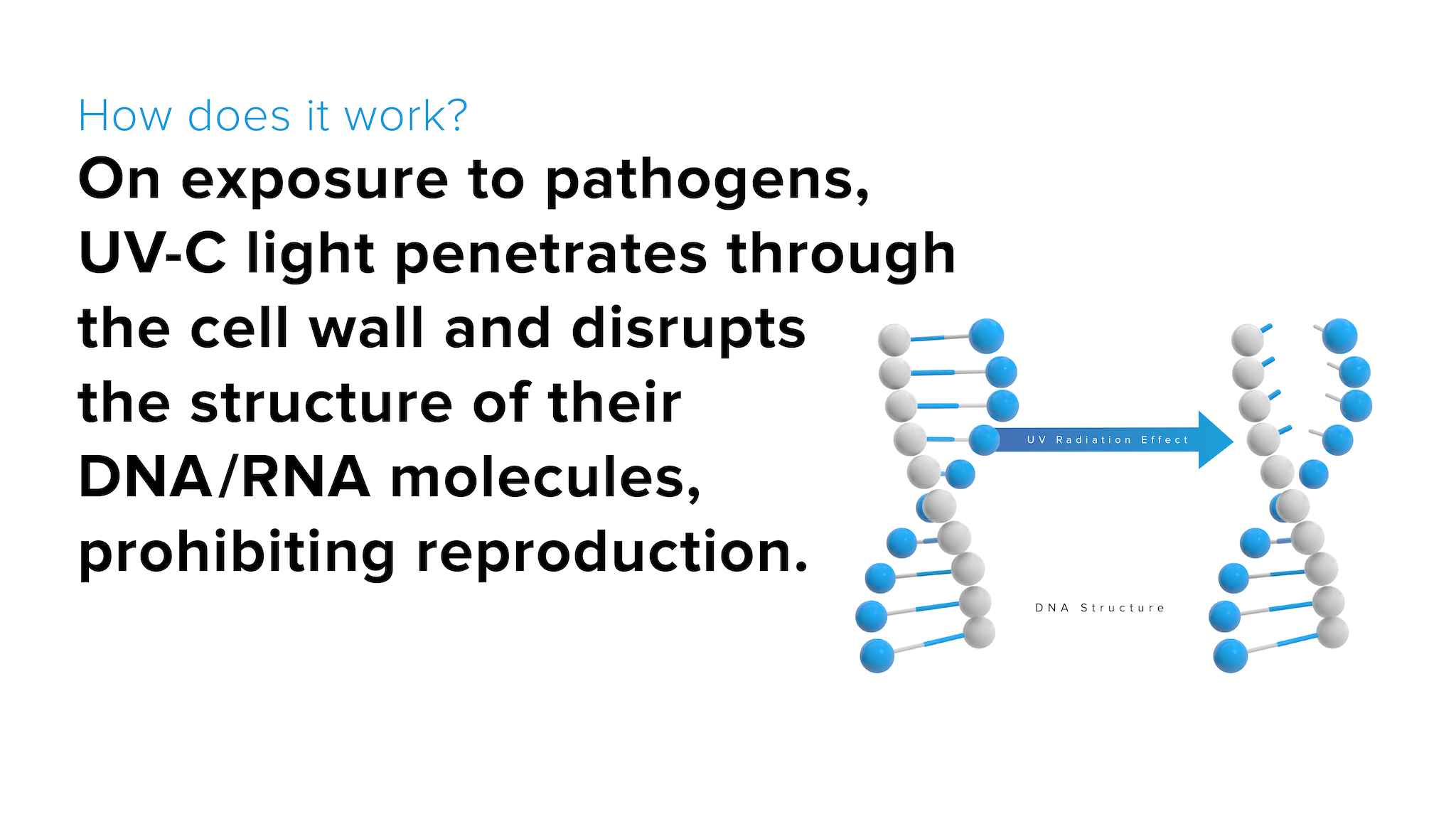What is UV-C?
To start, we should define UV-C. The short answer is that UV-C is one of three wavelengths of ultraviolet light, emitted naturally by the Sun as well as specially designed UV light bulbs. Ultraviolet sits on the electromagnetic spectrum alongside visible light, as well as infrared light and is in a category of light that is not visible to the human eye.

What can it do?
While UV-C (180-280 nm) is not commonly referenced, you’re likely aware of the other two forms of ultraviolet light—UV-A (315-400 nm) and UV-B (280-315 nm). These two are emitted by the Sun and can cause damage to our skin and lead to health concerns such as skin cancer and cataracts. UV-B rays have a short wavelength that reaches the outer layer of your skin (epidermis) while UV-A rays have a longer wavelength that can penetrate the middle layer of your skin (dermis).
Although UV-C is also emitted by the Sun, it cannot penetrate our ozone layer. Therefore, all UV-C radiation on earth comes from artificial sources. UV-C radiation can cause burns to the skin and eyes (photokeratitis), but due to low penetration depth, does not pose any major long-term health risks. UV-C light can be emitted by specially designed bulbs and harnessed as a tool for viral disinfection and infection prevention.

UV-C technology isn’t new, in fact it has been around since the 1930s and, due to its effectiveness, has been used for decades to inactivate viruses in water treatment facilities, building HVAC systems, and other facilities.
What about safety?
Disinfection with UV-C light is a process that should always be handled with care and with safety in mind. While UV-A and UV-B light is absorbed, UV-C affects the top layer of skin, and a UV-C disinfection solution should not come in contact with people or animals.
When considering a UV-C disinfection solution, a key component to look for is safety features. Are there measurements in place to help mitigate risk of exposure to operators as well as anyone in the area—such as detection features and automatic shutoffs? In an autonomous robotic solution, like the ADIBOT A1 for example, there are cameras, radar, and artificial intelligence features that detect human presence, obstacles, and pathways to ensure complete disinfection and safe operation.

Who is using UV-C for disinfection?
While it isn’t the only virus to consider or the first to warrant its use, COVID-19 has accelerated the awareness and adoption of UV-C in many environments where people interact. School districts are adding UV-C disinfection tools to supplement their existing cleaning protocols in classrooms and other areas to prevent outbreaks. Office facilities are introducing UV-C disinfection to ensure the health and wellness of their tenants.
Since it first began being used to mitigate viruses and infection, UV-C solutions have continuously evolved and use cases have continued to grow.
How do you use UV-C?
UV-C disinfection solutions come in many shapes and forms including handheld UV-C wands, UV-C purification systems to improve indoor air quality (IAQ), and UV-C disinfection robots that can easily become a member of your disinfection team as well as a tool. These UV-C disinfection robots have become more common and more widely adopted in Schools, Offices, Public Spaces, and more.
As the need for complete disinfection grows, the technology designed to deliver UV-C continues to evolve. The latest, and most impactful solution is autonomous robotics that combine technologies to provide safe, effective, and comprehensive disinfection.
At ADIBOT, we understand robotics and how well-designed, expertly built, and fully supported solutions make an impact. We know that there are important considerations when it comes to implementing a UV-C disinfection solution to protect the health of your customers, staff, and partners.

That’s why we built the ADIBOT A1 Autonomous UV-C Disinfection Robot. See it in action here.
UV-C for the future.
Although UV-C radiation has been utilized for decades, advancements in delivery systems are continuously evolving to accommodate a growing range of environments, making them an essential component of modern disinfection protocols. We’re excited to be at the forefront of that evolution.



